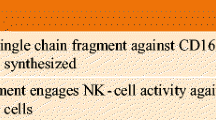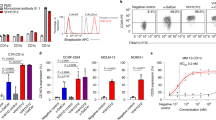Abstract
Cross-linking an anti-tumor antibody, specific for tumor cell surface antigens, and an anti-lymphocyte antibody, specific for the T lymphocyte receptor complex (TCR/ CD3), produces a heteroconjugate that can direct T cells to lyse tumor cells. We tested the ability of anti-tumor × anti-lymphocyte (CD3) heteroconjugates to redirect human peripheral blood lymphocytes (PBLs) to lyse human colon cancer cells in cytotoxicity assays and in a murine colon tumor model. We demonstratedin vitro,that cultured human PBLs alone produced low levels of tumor lysis, but PBLs treated with anti-tumor × anti-CD3 heteroconjugates produced significantly greater tumor cell lysis (P<0.0025). Similarly, nude mice injected with LS174T human colon cancer cells and treated with cultured human PBLs and anti-tumor × anti-CD3 heteroconjugates survived significantly longer than saline control mice (P<0.01), or mice treated with PBLs alone (P<0.01), or heteroconjugates alone (P<0.05). F(ab′)2heteroconjugates were equally as effective in prolonging animal survival, but irrelevant heteroconjugates and monoclonal anti-tumor antibodies showed no therapeutic benefit. Anti-tumor × anti-CD3 heteroconjugates may represent an effective approach to tumor-specific cellular immunotherapy.
Similar content being viewed by others
References
Kohler G, Milstein C. Continuous cultures of fused cells secreting antibody of predefined specificity. Nature 1975;256:495–7.
Herlyn D, Koprowski H. IgG2a monoclonal antibodies inhibit human tumor growth through interaction with effector cells. Proc Natl Acad Sci U S A 1982;79:4761–5.
Herlyn D, Powe J, Ross AH, Herlyn M, Koprowski H. Inhibition of human tumor growth by IgG2a monoclonal antibodies correlates with antibody density of tumor cells. J Immunol 1985;134:1300–4.
Rodeck U, Herlyn M, Herlyn D, et al. Tumor growth modulation by a monoclonal antibody to the epidermal growth factor receptor: immunologically mediated and effector cell-independent effects. Cancer Res 1987;47:3692–6.
Badger CC, Anasetti C, Davis J, Bernstein ID. Treatment of malignancy with unmodified antibody. Pathol Immunopathol Res 1987;6:419–34.
Lanier LL, Babcock GF, Raybourne RB, Arnold LW, Warner NL, Haughton G. Mechanism of B cell lymphoma immunotherapy with passive xenogeneic anti-idiotype serum. J Immunol 1980;125:1730–6.
Sears HF, Herlyn D, Steplewski Z, Koprowski H. Phase II clinical trial of a murine monoclonal antibody cytotoxic for gastrointestinal adenocarcinoma. Cancer Res 1985;45:5910–3.
Spitler LE, del Rio M, Khentigan Aet al. Therapy of patients with malignant melanoma using a monoclonal antimelanoma antibody-ricin A chain immunotoxin. Cancer Res 1987;47:1717–23.
Byers VS, Baldwin RW. Therapeutic strategies with monoclonal antibodies and immunoconjugates. Immunology 1988;65:329–35.
Lenhard RE, Order SE, Spunberg JJ, Asbell SO, Leibel SA. Isotopic immunoglobulin: a new systemic therapy for advanced Hodgkin's disease. J Clin Oncol 1985;3:1296–30.
Schulz G, Bumol TF, Reisfeld RA. Monoclonal antibody-directed effector cells selectively lyse human melanoma cellsin vitro andin vivo. Proc Natl Acad Sci U S A 1983;80:5407–11.
Eberlein TJ, Rosenstein M, Rosenberg SA. Regression of a disseminated syngeneic solid tumor by systemic transfer of lymphoid cells expanded in interleukin-2. J Exp Med 1982;156:385–97.
Rosenberg SA, Lotze MT, Muul LMet al. A progress report on the treatment of 157 patients with advanced cancer using lymphokine-activated killer cells and interleukin-2 or high-dose interleukin-2 alone. N Engl J Med 1987;316:889–97.
Schwab R, Crow MK, Russo C, Weksler ME. Requirements for T cell activation by OKT3 monoclonal antibody: role of modulation of T3 molecules and interleukin 1. J Immunol 1985:135:1714–8.
Van Wauwe JP, DeMey JR, Goossens JG. OKT3: a monoclonal anti-human T lymphocyte antibody with potent mitogenic properties. J Immunol 1980;124:2708–13.
Leeuwenberg JFM, Spits H, Tax WJM, Capel PJ. Induction of nonspecific cytotoxicity by monoclonal anti-T3 antibodies. J Immunol 1985;134:3770–5.
Hoffman RW, Bluestone JA, Leo O, Shaw S. Lysis of anti-T3-bearing murine hybridoma cells by human allospecific cytotoxic T cell clones and inhibition of that lysis by anti-T3 and anti-LFA-1 antibodies. J Immunol 1985;135:5–8.
Perez P, Titus JA, Lotze MTet al. Specific lysis of human tumor cells by T cells coated with anti-T3 cross-linked to anti-tumor antibody. J Immunol 1986;137:2069–72.
Jung G, Honsik CJ, Reisfeld RA, Muller-Eberhard HJ. Activation of human peripheral blood mononuclear cells by anti-T3: killing of tumor target cells coated with anti-target-anti-T3 conjugates. Proc Natl Acad Sci U S A 1986;83:4479–83.
Liu MA, Kranz DM, Kurnick JT, Boyle LA, Levy R, Eisen HN. Heteroantibody duplexes target cells for lysis by cytotoxic T lymphocytes. Proc Natl Acad Sci U S A 1985;82:8648–52.
Barr IG, Buchegger F, MacDonald HR, Carrel S, von Fliedner V. Retargeting of cytolytic T lymphocytes by heteroaggregated (bispecific) antibodies. Cancer Detect Prev 1988;12:439–50.
Lotze MT, Roberts K, Custer MC, Segal DA, Rosenberg SA. Specific binding and lysis of human melanoma by IL-2 activated cells coated with anti-T3 or anti-Fc receptor cross-linked to antimelanoma antibody: a possible approach to the immunotherapy of human tumors. J Surg Res 1987;42:580–9.
Bjorn MJ, Ring D, Frankel A. Evaluation of monoclonal antibodies for the development of breast cancer immunotoxins. Cancer Res 1985;45:1214–21.
Frankel AE, Ring DB, Tringale F, Hsieh-Ma ST. Tissue distribution of breast cancer-associated antigens defined by monoclonal antibodies. J Biol Response Mod 1985;4:273–86.
Pearson JW, Sivam G, Manger R, Wiltrout RH, Morgan AC Jr, Longo DL. Enhanced therapeutic efficacy of an immunotoxin in combination with chemotherapy against an intraperitoneal human tumor xenograft in athymic nude mice. Cancer Res 1989;49:4990–5.
Kehrl JH, Dukovich M, Whalen G, Katz P, Fauci AS, Greene WC. Novel interleukin-2 (IL-2) receptor appears to mediate IL-2-induced activation of natural killer cells. J Clin Invest 1988;81:200–5.
Parham P. On the fragmentation of monoclonal IgG1, IgG2a, and IgG2b from BALB/c mice. J Immunol 1983;131:2895–902.
Nelson H, McKean DJ, Kerr LA, Donohue JH. 1990. Anti-tumor X anti-CD3 heteroconjugates direct human peripheral blood lymphocytes to lyse colon tumor cells. J Surg Res 1990 (in press).
Karpovsky B, Titus JA, Stephany DA, Segal DM. Production of target-specific effector cells using heterocross-linked aggregates containing anti-target cell and anti-FCγ receptor antibodies. J Exp Med 1984;160:1686–701.
Beck BN, Glimcher LH, Nilson AE, Pierres M, McKean DJ. The structure-function relationship of I-A molecules: correlation of serologic and functional phenotypes of four I-Ak mutant cell lines. J Immunol 1984;133:3176–82.
Pross HF, Baines MG, Rubin P, Shragge P, Patterson MS. Spontaneous human lymphocyte-mediated cytotoxicity against tumor target cells. IX. The quantitation of natural killer cell activity. J Clin Immunol 1981:1:51–63.
Steel RG, Torrie JH. Principles and procedures of statistics. New York: McGraw Hill, 1960.
Titus JA, Garrido MA, Hecht TT, Winkler DF, Wunderlich JR, Segal DM. Human T cells targeted with anti-T3 cross-linked to antitumor antibody prevent tumor growth in nude mice. J Immunol 1987;138:4018–22.
Perez P, Hoffman RW, Titus JA, Segal DM. Specific targeting of human peripheral blood T cells by heteroaggregates containing anti-T3 crosslinked to antitarget cell antibodies. J Exp Med 1986;163:166–78.
Author information
Authors and Affiliations
Additional information
Read at the meeting of The American Society of Colon and Rectal Surgeons, St. Louis, Missouri, April 29–May 4, 1990. Dr. Nelson was supported by the Leon Hirsch Traveling Scholarship, awarded by the Research Foundation of The American Society of Colon and Rectal Surgeons. This material was acknowledged with a research award from the New England Society of Colon and Rectal Surgeons. Dr. Donohue is the recipient of a Cancer Development Award from the American Cancer Society.
About this article
Cite this article
Nelson, H., Ramsey, P.S., McKean, D.J. et al. Anti-tumor × anti-lymphocyte heteroconjugates augment colon tumor cell lysisin Vitro and prevent tumor growthin Vivo . Dis Colon Rectum 34, 140–147 (1991). https://doi.org/10.1007/BF02049988
Issue Date:
DOI: https://doi.org/10.1007/BF02049988




